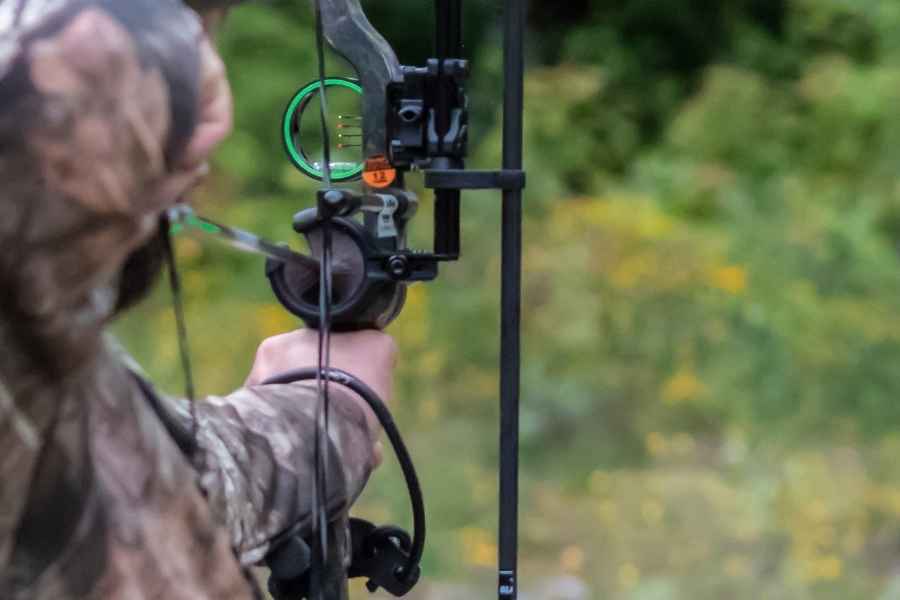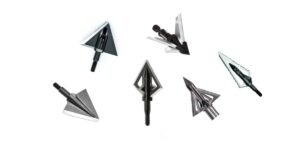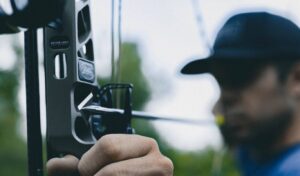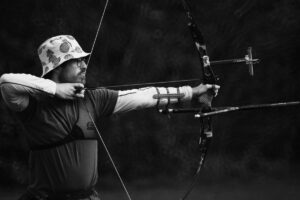As a beginner to archery, you might not have the strength to pull back the bowstring with as much weight (draw weight) as somebody who has been practicing archery for a while. I like comparing it to going to the gym – the more you work out the stronger you’ll eventually get. The more you draw that bow back, the easier it becomes which allows you to increase the weight of the limbs. If you increase the weight of the limbs, your arrow speed gets faster and the arch of your arrow gets flatter leading to increased accuracy and a more forgiving trajectory.
A bow with multiple draw weight settings will let you start low and gradually increase draw weights as you build your back and upper body strength. The draw length of the bow determines how far it can be drawn. Contrary to recurve bows, which you can draw back any distance, compound bows are engineered only to allow you to pull back a certain distance (draw length). This is why buying a bow that’s adjustable to your draw length is so important. A quick way to figure out your draw length is the armspan method.
It works by measuring your armspan and dividing that by 2.5 – I’ll explain later why. This section is for those who have just started learning how to shoot compound bows and would like a quick primer to get them up and running.
What Speed of Bow is Ideal for Beginners?
Speed is measured in FPS or feet per second, so if you’re a beginner looking for the best bow speed, it’s important to know what that means! It comes down to your draw weight and draw length. The higher your draw weight, the faster your bow is. There is more to it, but let’s keep it simple for now.
The ideal speed depends on your physics. 75% of the draw weight you could possibly pull back is what you should be aiming for. You should be able to draw your bow 20 times without being exhausted and requiring terrible form in order to get drawn back.
For example, If you could draw back a maximum of 50 lbs draw weight using terrible form and all your strength – 75% of this is 37.5 lbs. You should set your bow at a draw weight of 37.5 lb – which will directly influence the maximum speed you will reach. Once you get stronger and more experienced, you can slowly increase the draw weight, resulting in a higher FPS, more speed, and a flatter trajectory. So the question isn’t what SPEED is ideal but what DRAW WEIGHT is ideal for you. We can’t magically choose how much weight we can draw back but we can change, say, our arrow weight.
Draw Length
I briefly mentioned draw length before. So, what is it all about? It is an important number that you’ll need to set up your bow properly. Your individual draw length must match up with your bow’s draw length, otherwise your form will suffer! So how do you do it? I personally use the arm-span method. You basically stretch out your arms and let someone measure the distance from fingertip to fingertip.
Write down your findings and divide them by 2.5. The number you come up with will be very close, if not actually, your draw length. Make sure to buy a bow that corresponds to your draw length. Be sure to read our detailed article about draw length.
Draw Weight
At it’s core, this is the force you need to apply to draw the string back. It is measured in pounds. Due to the way compound bows are engineered, this process is not linear. Depending on how the cams are engineered will determine how the force is applied over the duration of the draw. At some point in the draw cycle (usually somewhere near the middle) you will hit the maximum amount of force required to draw a bow back. This force is measured in pounds.
Some of the best beginner bows for archery start with as low as 7 lbs draw weight. With regular practice comes more strength; eventually, you can increase your draw weight. This method allows helps protect your shoulders, wrists, and elbows from pain and injury. Slowly increasing your draw weight will allow your muscles to accommodate heavier loads over time.
The term “over-bowed” is used when your draw weight is too high for you. Too much draw weight can cause problems when you shoot, such as jerking the bow forward before release, unsteady aiming, and more. Your form and your accuracy will suffer.
Let-Off
Due to their amazing engineering, modern compound bows will reduce the weight you have to hold the bow at full draw. This reduction in weight held at full draw is referring to as “let-off”. It is calculated as a percentage of the total draw weight.
For example, a let-off of 80% means you’ll only hold 14 pounds at full draw on a bow with a set draw weight of 70 lbs ( 70 – (70 x .8) ). That doesn’t mean you’ll only have to draw 14 pounds. You still need the strength to draw the bow until you reach full draw. In some states, the maximum let-off for bow hunting is limited. Make sure to check your local rules and regulations. We’ve created a map to quickly help you find yours.
Since we are primarily hunters, we like a higher percentage let off. Once we draw our bow back we want to be able to hold that position for potentially minutes. A deer, turkey, elk, or whatever may stop in a very inopportune position requiring you to wait for an ethical shot to present itself. Letting down in this situation could alert the quarry and spook it, so being able to hold a minimal amount of weight has it’s benefits. The tradeoff of a higher let off does exist and that is the efficiency that cam operates at. Lower efficiency means a slower arrow and a more curved trajectory.
Backwall
The back wall is what you reach when you have drawn your bow completely (remember how we talked about setting draw length).
You will feel resistance once you reach the point of full draw. Some bows have rock-solid back walls; others have “softer”. It´s hard to explain, but once you have shot different compound bows, you will know what I am talking about.
I personally prefer a solid back wall, and I think it will help you to be more consistent with your form. No guessing if you pulled back as far as the last time. Every little change will have an influence on how accurately you can shoot. Consistency in execution is important to achieve replicable results.
Axle-To-Axle Length
Each cam of your compound bow rotates upon an axle. If you measure the distance between those (on center) to you’ll get your ATA (Axle-to-Axle).
Some bows have a longer ATA, others a shorter. If you plan to hunt from small confined places such as a ground blind, a shorter ATA might be useful as you need less room to operate your bow. If you are a target shooter – a longer axle-to-axle is preferable.
Speed
The speed of your bow is measured in feet per second. The correct abbreviation is fps. IBO speed is the speed at which an arrow with 5 grains per pound of draw weight is fired from a given bow.
A bow labeled with 270 fps is slower than a bow with 320 fps. IBO Speed specs are meant to standardize how bow speeds are measured across the industry so inaccurate claims won’t confuse consumers. You can read more about it in our article here.
Brace Height
What is brace heigth and how is it defined? It is the distance between the deepest part of the grip and the bowstring. If you are a beginner, every extra inch of brace height will make your bow more forgiving. This concerns how long the arrow is “pushed” and in contact with the bowstring.
For example, 30″ draw length with a 7″ brace height means you’ll draw the bowstring 23″. With the same draw length, but a 6″ brace height, you’ll draw 24″.
- Shorter brace height = longer draw. The arrow is longer in contact with the string, more room for mistakes, but higher arrow velocity.
- Greater brace height = arrow leaves bow string faster, less time to mess up, generally slower.
That’s why higher brace heights are generally more forgiving.
Determine Your Dominant Eye
Here´s a video about how to determine your dominant eye.
The importance of determining your dominant eye
You may wonder why it’s important to know which eye is dominant. That’s because if you don’t know your dominant eye, you’ll have problems while aiming at a target. You might always be a bit off – this greatly impacts your accuracy at long ranges. Since most archers’ dominant eye is on the same side of their dominant hand, this also indicates whether you are a right-handed or left-handed archer.
Are you a Left or Right-Handed Archer?
What is the difference between a right-handed and a left-handed archer? If your dominant hand is your right hand, You will hold the bow with your left hand and draw with your right hand. If your dominant hand is your left hand, You will hold the bow in your right hand and draw with your left hand.
Most bows nowadays are available in both right-handed as well as left-handed models.
The Types of Arrows and Broadheads for Different Game Animals
- Arrows are the shafts that are shot from a bow. They have different materials, lengths, weights, and spines that affect their flight and performance. Common arrows are carbon, aluminum, wood, and fiberglass.
- Broadheads are the arrowheads that are used for hunting. They have sharp blades that cut through the animal’s flesh and cause bleeding. Some common types of broadheads are fixed-blade, mechanical, and hybrid.
- Different game animals require different types of arrows and broadheads depending on their size, anatomy, and behavior.
Large game animals like elk, moose, and bear need arrows that can penetrate deep and broadheads that can cut well. Most hunters use fixed-blade broadheads.
Medium game animals like deer, hog and antelope, also need arrows that can penetrate deep and broadheads that can cut well. Fixed-blade and mechanical broadheads are commonly used.
Small game animals like rabbit, squirrel, and bird are most commonly hunted with blunt or small-cutting broadheads. For turkey hunting special broadheads are designed to deliver precise and lethal shots, typically featuring unique features such as wide-cutting diameters, razor-sharp blades, and sometimes even turkey-specific designs like “guillotine” or “razorback” broadheads.
Common Mistakes Newbies Make
Not Talking To An Expert
Don’t just purchase any bow just because it looks “cool.” The bare minimum you need to figure out is your draw length, draw weight, and eye dominance. Go to a bow shop near you, shoot different bows, listen to what the guys there have to say, and make an informed decision.
Buying Based on Price
Don’t buy a bow just because it’s cheap. A cheap-o bow might ruin your archery experience. A moderately priced bow makes buying your next one less stressful when you figure out what you like and don’t like.
Glossary
Compound bow archery can be a tricky sport to get into. With so many different terms, it is hard to know what they all mean. That’s why we have created this glossary of compound bow terms for beginners!
Here you will find definitions and explanations of some common compound bow words that are used in the world of archery.
Important Parts of Compound Bow
Riser
The riser is the “heart” of the bow. It connects to the bow´s limb pockets. Many risers are made out of Aluminum. Lighter versions are made of carbon.
The benefits of aluminum risers are that they are more affordable. The negative with aluminum risers is that they feel extremely cold when you are out and shooting your bow in the cold.
Carbon risers are even lighter than aluminum risers and feel not as cold when outside in frigid temperatures. Longer risers are easier to handle for beginning archers. Shorter risers are more maneuverable, especially in confined places such as a ground blind.
Bow Grip
This is basically where you hold the bow. Some bows (risers) have a direct-to-riser grip. Others have the grip screwed or glued to the riser.
Limbs
The bow limbs are what “powers” your bow. They store the energy needed to accelerate the arrow towards the target. If you damage your bow, it will most likely be the limbs that suffered. Most popular are split-limb designs and single-limb designs.
Limb Pocket
It is here that the limbs attach to the riser. While some of these items are machined, others aren’t. Particularly at a greater distance, those that are are more accurate.
Limb Bolts
Usually, limbs are attached to the riser by sliding into limb pockets provided by the riser and then bolted on by the limb bolts.
Cams
The cams are what make your bow a compound bow.
Cam on a Diamond Archery Deploy Bow
- Single cam system – One round wheel at the top of the bow, power cam at the bottom
- Hybrid-cam system – Two elliptical cams, power cam at the bottom and control cam at the top
- Binary-cam system – Two elliptical cams, self-correcting any imbalances, introduced by Bowtech
- Twin-cam system – Two symmetrical round or elliptical wheels. One at the top, the other at the bottom. Need more maintenance, offer high accuracy and speed.
Cables
- Single-Cam bows have one cable and one long string
- Dual-Cam bows have two cables and one string
Cable Guard
In compound bows, cables are running the cams. If you draw your bow, you don’t want those cables to get into the path of your arrow. A cable guard does exactly this – pulling the cables aside so that the path is clear when drawing and releasing the arrow.
Center Serving
A serving material is used to protect your bowstring from nocking and drawing and it also provides a better fit for your arrow nock.
Arrow Rest
An arrow rest does what its name implies. It holds the arrow in place. There are basically two different kinds of arrow rests available:
- containment rest
- drop away arrow rest
Here is an example of a containment-style arrow rest:
Whisker Biscuit Arrow Rest
And here is an example of a drop-away arrow rest:
Drop Away Arrow Rest
Bow Sight
Compound bows are usually fitted with a pin sight. Those are used to aim at targets – with every pin resembling the distance to the target. More pins offer a more granular approach by providing more distances.
Peep Sight
In archery, the Peep Sight plays an important role in accuracy and consistency. It assists you while aiming at the target. The sight is generally attached to the bowstring by a serving material between the strands. You line up the peep sight with the bow sight when you’re at full draw.
There are several types of peep sights. The smaller the diameter, the more precise you can aim. The disadvantage of a smaller diameter is, that in low light conditions, it is harder to keep your target in focus.
That’s why the most common size for hunters is slightly larger.
Release
A release helps you draw the bowstring back. You attach the caliper of the release to the D-Loop. Now you pull back the bowstring (draw), at full draw and after (hopefully) proper aiming, you trigger the release aid via thumb or index finger to open the caliper which allows the string to push the arrow from the bow and toward the target. Modern compound bows allow for very high draw weights. Drawing a high poundage bow with fingers would be difficult and uncomfortable.
D-Loop
Also called string loop. This is where you attach your release aid to the bowstring. The D-Loop should not move. Otherwise, it will affect your accuracy.
Stabilizer
Bow Stabilizer
The stabilizer is attached to the riser and reduces the vibration and noise of your bow once fired. It also helps to balance the bow, due to its weight. There are many different stabilizers available to match the needs of any archer.
Wrist Sling
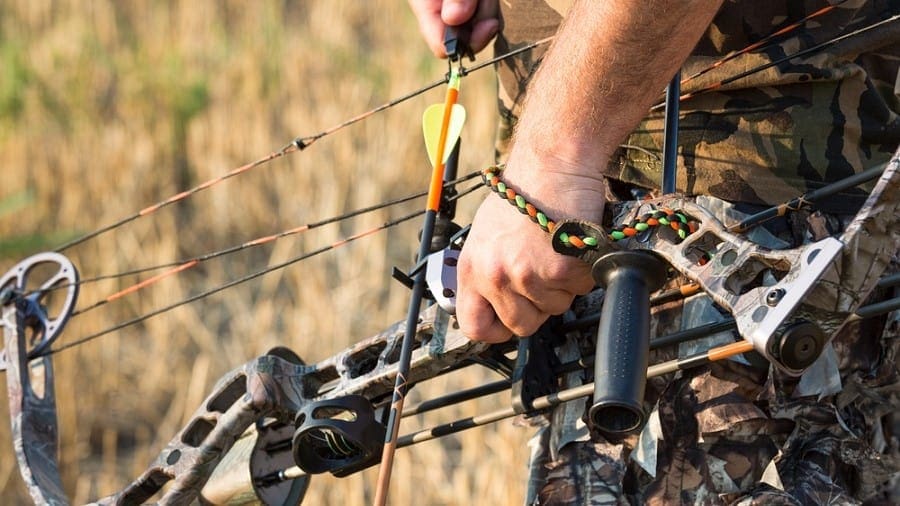
Wrist Sling
The idea of the wrist sling is, to help you keep your bow hand relaxed before and during the shot. It is not necessarily needed but it psychologically helps. Y
ou don’t have to worry about dropping the bow. The stronger you grab and hold the bow, the more likely it is an error or inaccuracy will happen.
Think about it this way: the bow by itself (given a proper tuning) would shot totally straight. You clinging onto the bow and subconsciously moving it is a possible point of failure.





